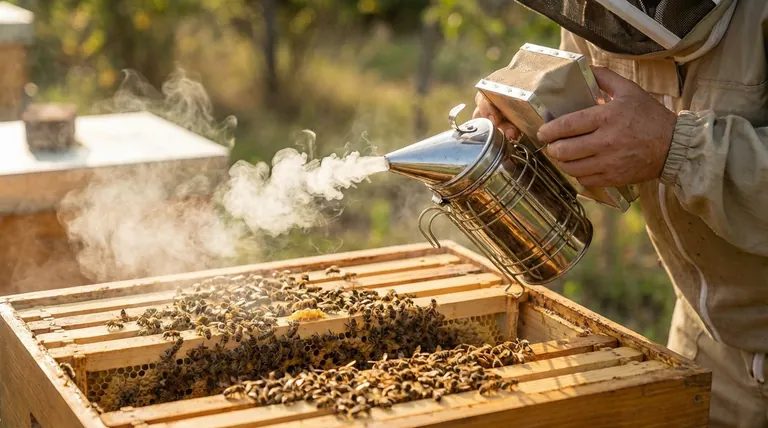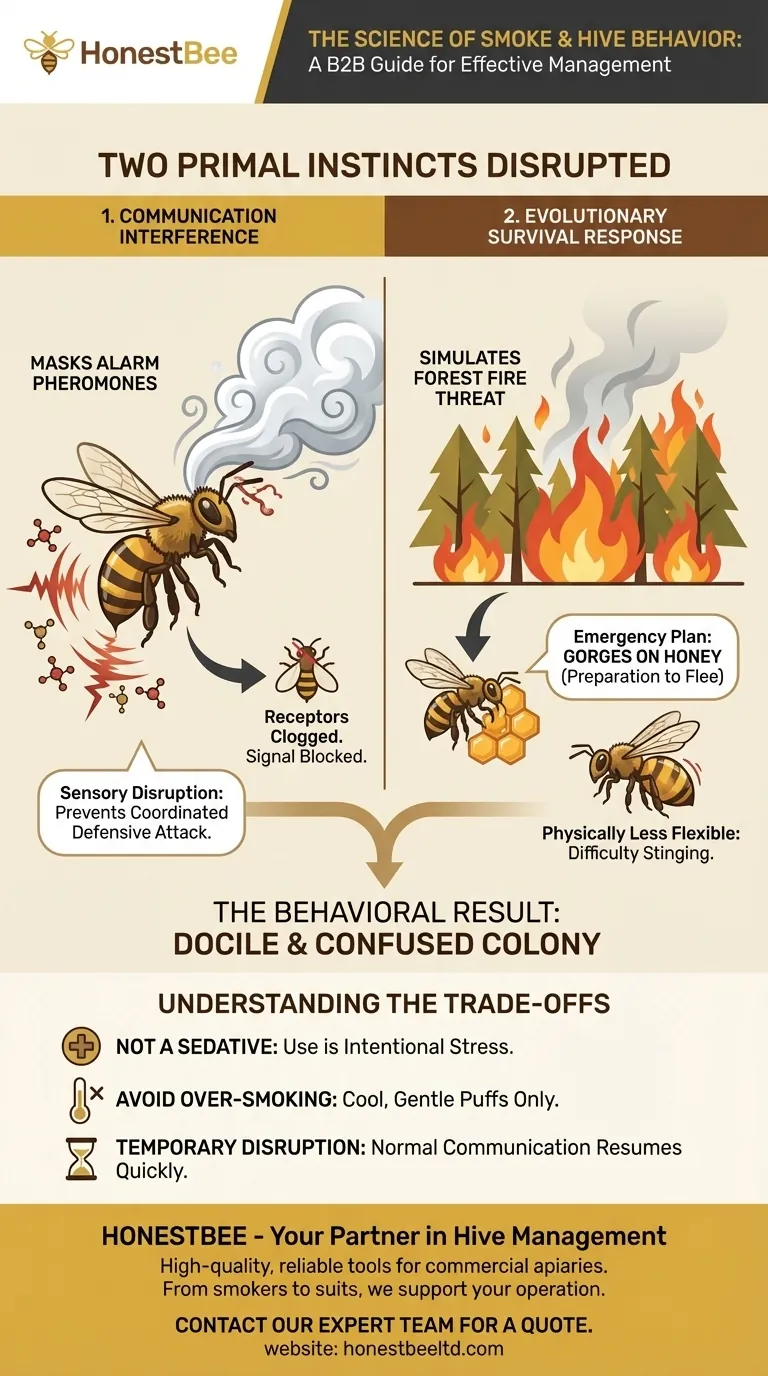At its core, smoke works by exploiting two of the honeybee's primal instincts. It interrupts their primary method of communication and triggers an ancient survival response. The smoke masks the alarm pheromones that guard bees release to signal a threat, preventing a coordinated defensive attack. Simultaneously, it tricks the bees into thinking their hive is threatened by fire, causing them to focus on eating honey in preparation to flee, which makes them more docile.
Using smoke isn't about tranquilizing bees; it's a form of sensory disruption. It works by creating a controlled state of confusion, blocking their defensive communication network and activating their emergency plan for a forest fire.

Disrupting the Hive's Communication Network
A bee colony operates as a superorganism, relying on a complex language of chemical signals called pheromones to coordinate its behavior. Smoke 금액 this system directly.
The Role of Alarm Pheromones
When a guard bee perceives a threat, or if a bee is injured, it releases alarm pheromones. The most notable of these are isopentyl acetate, which smells like bananas, and 2-heptanone.
These chemicals are an immediate call to arms, signaling to other bees in the vicinity to become defensive and attack the source of the disturbance.
How Smoke Masks the Signal
The particles in cool, white smoke overwhelm the bees' sensory receptors located on their antennae. This interference works in two ways.
First, the smoke physically "clogs" the receptors, preventing the pheromone molecules from binding to them. Second, the sheer volume of new smells overwhelms their ability to detect the specific, subtle alarm signal. The alarm is sounded, but no one can hear it.
The Behavioral Result
Without a clear, colony-wide signal to attack, the hive's defensive response breaks down. Instead of a coordinated assault, you have thousands of individual bees that are confused and uncertain. This gives a beekeeper a critical window to open and inspect the hiveFrame.
Triggering an Evolutionary Survival Instinct
Beyond simply blocking communication, smoke activates a much deeper, more powerful instinct 행동 by simulating a natural disaster.
The Forest Fire Response
For millions of years, smoke has meant one thing to honeybees: fire. A forest fire is وزن existential threat that could destroy their home and all their resources.
When bees detect smoke, their colony's top priority shifts from defense to survival and potential relocation.
Gorging on Honey
The bees' emergency plan is to "pack their bags." Their most valuable portable resource is honey. In response to the smoke, worker bees will begin to gorge themselves on honey, filling their stomachs in case they have to abandon the hive and build a new one elsewhere.
The Calming Side-Effect
This feeding frenzy has a useful physiological side-effect. A bee with a full abdomen of honey is physically less flexible.
This makes it difficult for her to angle her abdomen पुलिस the proper position to sting. This, combined with their focus on eating, makes them significantly more lethargic and less inclined to attack.
Understanding the Trade-offs
While effective, it's critical to understand that smoke is a tool that induces stress, not a sedative. Using it improperly can do more harm than good.
It's a Stressor, Not a Sedative
The bees are not "calm" in a relaxed sense. They are preoccupied with what they perceive as an impending apocalypse. You are intentionally stressing the colony to override its defensive instincts.
The Risk of Over-smoking
Using too much smoke, or smoke that is too hot, can be counterproductive. It can cause bees to become agitated, damage their sensitive respiratory systems, and even taint the honey with a smoky flavor. The goal is gentle puffs of cool, white smoke.
It Is a Temporary Disruption
The effects of smoke are not permanent. Once the smoke dissipates, the bees' sensory organs will clear, and their normal pheromonal communication will resume within minutes.
How to Apply This to Your Project
Understanding these mechanisms allows for a more respectful and effective approach to hive management. Your goal dictates how you should apply it.
- If your primary focus is a routine inspection: Use smoke minimally. A few gentle puffs at the entrance and under the lid are often enough to mask initial alarm pheromones and allow you to work calmly.
- If your primary focus is managing a known aggressive hive: Use smoke more deliberately to interrupt the defensive cascade. Apply it before the bees have a chance to mount a coordinated response, giving them time to switch to他們的 feeding instinct.
- If your primary focus is the long-term well-being of the colony: Always view smoke as a necessary stressor, not a simple "off switch." Use it judiciously and as gently as possible to achieve your goal while minimizing disruption to the hive.
By understanding you are overriding instinct, not just pacifying bees, you become a more effective and responsible steward of the hive.
Summary Table:
| Aspect | Key Effect of Smoke |
|---|---|
| Communication | Masks alarm pheromones, preventing a coordinated defensive attack. |
| Behavior | Triggers a 'fire response,' causing bees to gorge on honey. |
| Result | Bees become docile and less likely to sting during hive inspections. |
Ready to conduct hive inspections with confidence?
At HONESTBEE, we supply commercial apiaries and beekeeping equipment distributors with the high-quality, reliable tools needed for effective hive management. From smokers to full protective suits, our wholesale-focused operations ensure you get the durable equipment your business depends on.
Let's discuss your needs and how our products can support the health of your colonies and the success of your operation.
Contact our expert team today to request a quote!
Visual Guide

Related Products
- Stainless Steel Honey Bee Smoker Hive and Honeycomb Smoker for Beekeeping
- European Stainless Steel Bee Smoker for Honey Bee Hive
- Premium Traditional Copper Bee Smoker with Bellows
- Stainless Steel Electric Beehive Smoker for Beekeeping and Bee Keeper Use
- Electric Bee Smoker European Style Bee Hive Smoker for Beekeeping
People Also Ask
- What is the smoke that beekeepers use? The Secret to Safe and Calm Hive Inspections
- What is a bee smoker and how does it work? Master the Tool for Calm, Safe Hive Inspections
- How did early beekeepers use bee smokers? Master Ancient Bee Calming Techniques
- What is the proper technique for lighting a bee smoker? Master the Layered Fire Method for Calm Hives
- What is a Smoker and how is it used in beekeeping? The Essential Tool for Calm, Safe Hive Inspections



















